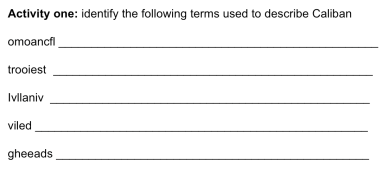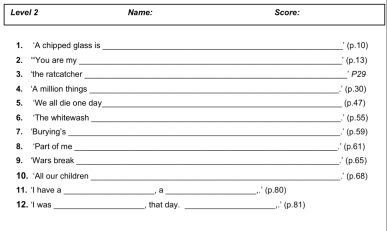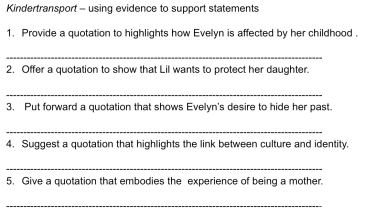‘a quotation is a handy thing to have about, saving one the trouble of thinking for oneself, always a laborious business.’ A.A. Milne
I’ve always been rather envious of those who can effortlessly pull out a quotation to match a given situation or circumstance. As an English teacher, it is useful to have an apt line or phrase to hand to exemplify a teaching point, or help students to see connections between different texts both past and the present. A good quotation is a thing of beauty in and of itself – a short, often poetic utterance that can say something of what it means to be human even when shorn of its surrounding context.
I would imagine a lot of people think learning quotations is a bit of a waste of time and, along with memorising poems, an outmoded example of the kind of Stephen Fry cum Oscar Wilde infused wit that everyone admires of eccentric public figures, but not of themselves or their close friends. If such a view exists, I think it is a rather sad indictment of our age where learning things off by heart – like the names of songs on your favourite album or even the name of the album itself – is often seen as pointless given the efficiency of cloud-based repositories in the sky.
In the context of examinations, the need to learn content off by heart is called into question even more. Why should students need to learn lines of poetry to do well in English? In what way does remembering a series of quotations from a novel count as evidence of deep learning? These questions have been raised a lot of late with the introduction of a greater number of closed book examinations in English, at both GCSE and A Level. The concerns have been loud enough to warrant Glenys Stacey to release this statement about the requirements of the new toughened GCSE syllabus, in which she assures all that ‘there is no expectation that students should have to regurgitate paragraphs of text’ and that ‘assessment is about learning and understanding, not memory.’
In some respects I am broadly sympathetic to the sentiment of Stacey’s words. Nobody can learn or remember everything, and in an age when so much is available at the touch of a button, or the swipe of a finger, there are times to focus less on the small details and concentrate more on the bigger picture. Whilst Stacey’s view of the distinction between learning and memory may be a little confused (isn’t all learning a form of memory?), I understand there is a difference between superficial retrieval and deep analysis. In no way do I think students should be disadvantaged if they cannot recall the precise words a writer uses when they are casting around for evidence in support of an interpretation. Great readings of texts are not dependent on a given quota of textual references, yet they can certainly be enhanced by one or two well-deployed quotations made by a skilful student.
I think therefore that there is something eminently worthwhile for students in learning lines from the texts they study in class or books they read at home. From a practical point standpoint, a well-selected quotation can stimulate deeper language analysis or act as a cue for links to other ideas and interpretations across a text. More importantly, learning the words of the writer, whether in writing or out loud, can show a greater appreciation of their ideas and feelings – their purpose even. I’m with Andrew Motion, who has a great affection for line the ‘sun destroys the interest of what’s happening in the shade’ from Larkin’s Whitsun Weddings. The quotation contains an image I think I will remember for the rest of my life, and which I don’t think is lessened from being uncoupled from the poem itself.
Up until a couple of years ago, I never really took any meaningful steps to help my students learn quotations. I guess I just thought that through osmosis they would remember important lines and powerful images like the Larkin one above. I used to write ridiculous targets in their reports in the lead up to exams, such as ‘Charlotte should create a bank of quotations to support her arguments in essays’, or ‘Josh should aim to learn quotations to support the main ideas and themes.’ It was one thing for me to put the onus of learning onto the students, but at the very least I should have provided them with some kind of structure: guidance on which quotations to choose, advice on how to learn them or use them effectively in their writing, and a clear rationale for their long term ‘utility’.
Since I have started to focus much more on helping my students remember quotations, I have developed a number of different approaches, which I think have proved successful across the age and ability range. My year 11 class can reel off well over 20 quotations from each of their three set texts and they can explain their importance in relation to the key themes. Crucially, I think learning words and phrases has helped them appreciate what the writer is trying to communicate, and, in turn, more about the writer as a human being. My year 13 class know a large number of the terms used to describe characters in The Tempest and can readily provide textual evidence to support statements about the main ideas and attitudes. I am finding that having a common currency of learnt quotations significantly enhances our ability to talk about the play with confidence and make sophisticated interpretations and connections as a class. Learning quotations is not the be all and end all, but in my opinion it is contributing to my students demonstrating some pretty deep understanding in their work.
And so, in the spirit of sharing, here are some short descriptions of the main approaches I have been using with my students, together with some illustrative examples. In the cold light of day they seem pretty feeble, but I can vouch for the fact that they are making a difference to my students’ learning.
- Repeated recall
In most of my sixth form lessons, though increasingly more so as we get closer to the examinations, I begin with some kind of short activity that supports the learning of quotations. I often use the same activity several times, returning or tweaking an earlier resource once a period of time has elapsed for forgetting. At first the students think they are never going to learn the quotations, but they soon start to see a difference and genuinely find the process and the result rewarding.
- Missing words
This is the activity I use the most. I select about 10 quotations and present them to the students with one, two or three words removed. I usually choose the words with the greatest semantic resonance, because this then enables elaboration for language analysis. As students gain more confidence, I extend the number and scope of quotations and increase the amount and type of words taken away. I provide opportunities for students to select and recall their own choices and, to my surprise, include random examples, which more often than not the students get right. The end goal is for students to be able to remember as many quotations as they can entirely from free recall, and then use these wisely to enhance their analysis and interpretation. What is effectively an oral start to the lesson provides fruitful stimulation for the transition into extended writing tasks.
- Anagrams and puzzles
A few years ago I think I would have poo pooed this approach, deeming it too simplistic and not worthy as a genuine learning activity. My increased understanding of how memory works and the different ways in which students need to process information in order to make it stick have meant that I now include much more of this kind of low stakes quizzing. It works particularly well for terms that characters use to describe or refer to each other, such as the myriad of names used to refer to Caliban in The Tempest. I don’t spend long on anagrams and puzzles; the trick is little and often. Knowing well over 15 terms used to define Caliban has helped the students really understand the way in which his character is positioned by language.
- Catch phrase (well, sort of)
This activity is my attempt at applying the rationale building memory palaces to regular short-term lesson starters. Memory palaces are excellent ways of learning quotations – the different rooms and use of imaginative images to support learning lends itself well to remembering vivid images in texts – but they are time-consuming to set up in class, and more suitable for students to complete at home. My version of using images to form connections with words is much quicker and more simplistic. I simply select an image or combination of images from Google and then lay them out on a PowerPoint slide as prompts for student recall. You can have a lot of fun with this and make the images as easy or hard as you like, depending on age, ability and level of student confidence. Students are also encouraged to select their own images as they build up their own quotation libraries. The image

- Exemplifying statements
This is a fairly straightforward variation on the ideas outlined above and is more suited to when students have some degree of mastery over a wide range of quotations. I begin (or sometimes end) the lesson with ten short statements about the text being studied, for which students have to supply some evidence by way of quotation. The great thing about this technique is that you can have the 10 propositions all together (on a slide or handout) or show them one by one and target certain individuals with the minimum of notice. Again, this approach lends itself to differentiating across and within classes. Once more, it leads effortlessly into elaboration, either by linking the quotations to other ideas or contextual details or deepening understanding through commenting on the methods of presentation used.
Healthy competition
Of late, I have combined some of the above approaches and introduced an element of in class competition. With my year 11 class I began with what I called level 1 quotation tasks, where I presented about 10 or so quotations to be learnt with one or two words missing. Once successfully completed, level 2 tasks were given where the same quotations were present but with different words omitted. Level 3 took away most of the words except the first one or two to serve as a cue, whilst introducing 5 or so new ones. Level 4 progressed to a combination of images and prompts, whilst level 5 (where some of the students are currently at) is solely image based. It sounds complicated, but in reality is quite simple. The students seem to like the additional competition, and all of them have learnt a lot of quotations in a relatively short amount of time. It stretches the more confident yet supports those that need more prompts.
I have blogged before about one of my favourite books of recent years, Reality Hunger David Shields. The book is a collage of quotation by various thinkers and writers about our obsession with ‘the real’ in art, literature and culture, each unattributed quotation is numbered and organised into chapters with letters from the alphabet. Quotation number 273 sums up the spirit of this post:
My taste for quotation, which I have always kept – why reproach me for it? People, in life, quote what pleases them. Therefore, in our work, we have the right to quote what please us.






A little learning is a dangerous thing;/ Drink deep, or taste not the Pierian spring.
ia interested to study english at anywhere